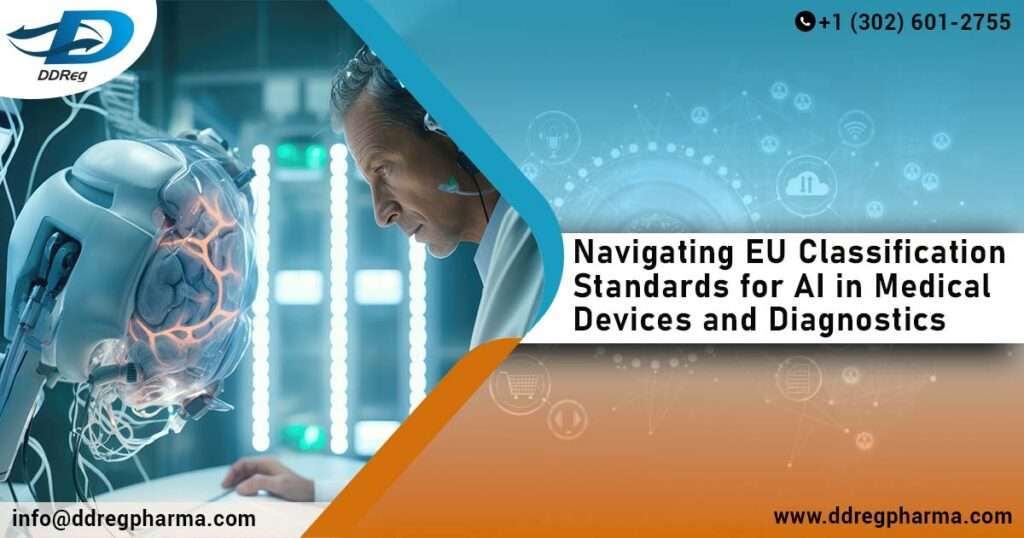The European Union (EU) has introduced stringent classification standards for Artificial Intelligence (AI) applications in medical devices and in vitro diagnostics (IVDs) to ensure patient safety, product efficacy, and compliance with regulatory frameworks. With AI technologies, these standards are crucial in defining the pathway for their integration into healthcare systems. This blog dives into the EU Classification of AI medical devices to help bring innovative and safe AI-based medical devices to the EU market.
Two main regulations in the EU govern the regulatory framework for AI in medical devices and IVDs-
- Medical Device Regulation (MDR) 2017/745: This regulation covers AI-driven medical devices. AI technologies that assist in the diagnosis, treatment, or monitoring of health conditions fall under this category.
- In Vitro Diagnostic Regulation (IVDR) 2017/746: For AI applications in diagnostics, IVDR governs products that analyze biological samples (blood, tissue, etc.) for medical purposes.
On 12 July 2024, the European Union took a significant step towards regulating Artificial Intelligence (AI) with the publication of the Artificial Intelligence Regulation (AI Act) in the Official Journal of the European Union. Regulation (EU) 2024/1689 establishes harmonized rules governing the development, market placement, and usage of AI systems, including those in the medical sector, which encompasses medical devices and in vitro diagnostics (IVDs). This legislation introduces new compliance and classification standards, reshaping the regulatory landscape for AI-driven technologies in healthcare.
EU Classification Criteria
AI in medical devices and IVDs are classified based on the risk associated with their usage. The criteria take into account factors such as
- Intended Purpose: How the AI system is intended to be used in clinical or diagnostic settings.
- Level of User Interaction: Whether the AI operates autonomously or requires human oversight.
- Impact on Patient Safety: The potential risks or consequences of the AI system malfunctioning.
The MDR divides medical devices into four classes, ranging from low-risk to high-risk (Class I to Class III), with AI-powered medical devices often falling into higher-risk classes due to their autonomous decision-making capabilities. Similarly, under IVDR, AI-driven diagnostics can range from Class A (low risk) to Class D (high risk), depending on the potential for harm.
Under the new AI regulatory framework, AI systems integrated into medical devices and IVDs are classified primarily as “high-risk” due to the potential impact they have on patient safety and health outcomes and could pose significant risks to health, safety, or fundamental rights, should they malfunction or operate in unintended ways.
For these high-risk AI medical devices, the AI Act mandates a rigorous regulatory process. These devices are subject to third-party conformity assessments conducted by notified bodies which verify their compliance with both the AI Act and relevant medical device regulations, such as the Medical Device Regulation (MDR) and In Vitro Diagnostic Medical Device Regulation (IVDR). This dual-layered compliance ensures that AI systems not only meet safety standards in terms of AI functionality but also adhere to stringent medical device regulatory requirements.
Timelines for Application
The AI Act introduces a phased approach to implementation-
2 February 2025 | General provisions and rules on prohibited practices (Chapters I and II) come into force. These include restrictions on certain AI practices deemed to pose an unacceptable risk.
|
2 August 2025 | Several key provisions come into effect, including: · Notifying authorities and notified bodies (Chapter III, Section 4) · Classification rules (Chapter V) · Governance structures (Chapter VII) · Penalties for non-compliance (Chapter XII) · Confidentiality requirements (Article 78)
|
2 August 2026 | The AI Act fully applies to all AI systems, including medical devices and IVDs, with some exceptions. |
2 August 2027 | Obligations specific to high-risk devices, such as third-party assessments, will be enforced. |
Ethical and Transparency Considerations
The EU Artificial Intelligence Act, a legislative proposal aims to complement the MDR and IVDR by setting specific standards for high-risk AI applications, including medical devices and diagnostics.
Manufacturers must ensure that AI algorithms used in medical devices and IVDs are transparent, explainable, & auditable and align their development processes with the stringent compliance requirements of the AI Act, MDR, and IVDR. This includes documenting how AI systems arrive at clinical decisions and ensuring that users can interpret and act upon AI-driven outputs correctly.
Challenges and Opportunities in EU Classification
While the EU’s classification standards help mitigate risks, they also present challenges for manufacturers. AI technologies often evolve rapidly, and keeping up with regulatory compliance can be resource-intensive. The high-risk classification of many AI-driven devices under MDR and IVDR necessitates a rigorous development and post-market monitoring process.
However, the introduction of clear standards also opens opportunities for innovation. By adhering to EU classification standards, manufacturers can foster trust in AI-driven solutions, paving the way for the broader adoption of AI in diagnostics and healthcare.
Conclusion
The EU regulations regarding AI in medical devices and in vitro diagnostics have become critical to the protection of AI-driven healthcare system from the patient’s perspective since AI integration in healthcare systems is only to be safe and efficient if the corresponding AI regulations are properly followed. Over the years as the healthcare sector undergoes significant modifications due to the implications of AI, such codes will no doubt be adjusted to keep up the right harmony of the policy for the benefit of the patients as well as for the technological advancements.
Reach out to DDReg for expert regulatory services and tailored solutions for medical device registration in global markets. Read our blog – Specifications for In Vitro Diagnostic Devices

